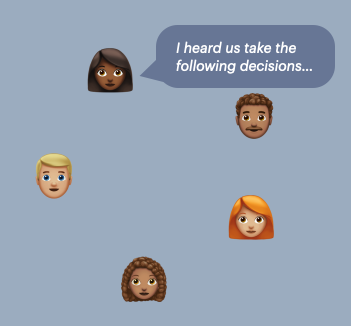Achieving shared understanding is crucial in a business, collaborative and goal oriented context. Having a way to validate if shared understanding exist in a group is key. Yet, I repeatedly see teams that fail to recognise their lack of shared understanding. Particularly around decisions they’ve made. With the following simple exercise a group can clearly highlight decisions they’ve made. In a nutshell it consist of 2 steps:
- At the end of the discussion each participant writes down all decisions that were made during the discussion.
- In a round the table fashion participants read out each decision as the others take notes whether they agree, disagree or aren’t sure of the outcome.

How I’ve used it in context
Some time ago a team asked for my support. They had identified a tension that mainly seemed to stem from their weekly planning meeting. Despite having planning meetings they weren’t satisfied with their outcomes by the end of each week. They were also unable to clearly articulate reasons for their dissatisfaction. Members presented different perspectives, e.g. “we don’t follow through on our commitments”, “we identify more urgent and important work during the week” or “we spread too thin”. Based on this they asked me to join the next planning session as an observer and share my findings.
During the hour long planning I exclusively watched, listened and took some notes. It turned out to be a ‘traditional’ planning session where members discussed various opportunities, challenges, short/mid/long term goals, backlog items, past learnings, customer experiences etc. There had also been some disagreements, and airtime between members hadn’t been distributed equally. When the meeting ended they all, in unison, silently and eagerly turned their heads towards me and without saying anything asked for me to speak.
As I momentarily gathered my thoughts my mind was filled with ambiguity and curiosity. Ambiguity about the coming week’s work and goal, and curiosity about how to resolve my ambiguity. This made me think of an exercise that I believed could bring both clarity and insight. So, I asked the team if I could run an exercise instead of sharing any findings, since I believed it might bring more value. They gave me permission and I proceeded with the following facilitation.
- Ask each participant to individually write down all decisions that was made during the meeting in a list.
- Ask a participant to read out their list of decisions with a small pause between each statement.
- For each statement that is read out loud ask other participants to put a bar in one of three columns : “I agree we took this decision”, “I don’t agree that we took this decision”, “I’m unsure we took this decision”
- Repeat 2-3 for every participant.
- Ask all participants to share their filled out columns with the whole group.
- Discuss results, take-aways and potential interventions.
The result
As everyone looked at the results it became instantly clear to the team that they lacked shared understanding of the outcomes. There were both visual and audible signs that the team gained key insights on how to start resolving tension. (e.g. wide opened eyes, tilting of heads, small sighs and laughs and a few ‘oh’s’ ) Since everyone though the exercise had had such profound impact and people were hungry we left for lunch without discussing take-aways. On a personal note I saw enough signs to believe they were going to figure out next steps without my support.

The remaining notes from other members indicated a similar pattern.
Learnings
As I stated earlier this exercise is great at highlighting the level of shared understanding a team has coming out of a collaborative meeting. It also hints at what influences the level of shared understanding. Achieving shared understanding is crucial in a business, collaborative and goal oriented context. Anecdotally it’s also profoundly challenging, and too few organisations excel at it. In general organisations lack insight on factors that influence shared understanding. In my next post I will expand on this topic and provide a holistic tool.